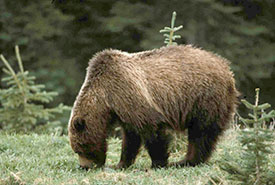Grizzlies of the Grasslands

Grizzly bear, AB (Photo by Mike Gibeau)
Grizzly bears are one of the largest, most iconic predators in North America. While their current range consists of mainly mountains and dense forest habitats, they actually evolved in the Prairies. And now there is evidence that they are returning.
Grizzly bears in Canada once ranged from British Columbia all the way to southwestern Saskatchewan. However, as settlers pushed west, grizzlies were driven from their native range and pushed northwards and westwards. Currently, most grizzlies in Alberta live in the Rocky Mountains and the northern tip of the province. But that is changing.
Southwestern Alberta is characterized by a stark change between mountains and grasslands ecosystems. Most of the grassland in this area is under private ownership and is used for agriculture and cattle grazing. In recent years, more and more grizzly sightings on ranches have been reported. Bears have been spotted as far east as the McIntyre Ranch, which is 30 minutes south of Lethbridge.
The general trend of grizzly populations across Alberta is considered stable to increasing, so the expansion of bears eastward is not surprising. Andrea Morehouse, the Waterton Biosphere Reserve Carnivores and Communities Program Science Lead, has been monitoring these bears. When asked if the bears are establishing territories in the grasslands or just wandering away from their home ranges in search of food, she confirmed they are living in the grasslands.
"They're living there, though we don't have great data on how they are using this landscape,” she said. “Radio collars would provide insight into their habitat use and movement, but currently no bears are collared."
Grizzlies are well adapted to living on the Prairies, and there is plentiful food available. Their prairie diets consist of berries, insects, ground squirrels and ungulates. However, bears are opportunists, and when given the opportunity, they will not hesitate to prey upon livestock or steal agricultural products such as grain. Issues have arisen with bears taking advantage of this easy food source.
Genetic studies have shown that there is a social component to which bears show conflict behaviors, as mother bears who encroach on human resources teach their cubs the same behaviors.
Andrea acknowledged this issue. “There is a difference between ecological and social carrying capacity,” she said. “People like seeing bears on the landscape, but they also want to be safe.”
Ecological carrying capacity is how many animals the ecosystem can sustainably support. Social carrying capacity in this context is the number of animals that humans will tolerate on the landscape before conflict arises.
To lessen the issues of coexistence, local residents and the Waterton Biosphere Reserve Association have established a program called the Carnivores and Communities Program. This initiative is led by landowners and ranchers focused on conflict mitigation and prevention. Initiatives include community outreach and education, dead livestock removal and erecting deterrents such as bear-resistant grain bins and electric fencing. As science advisor for the program, Andrea states that the program has become very successful.
“The key is to maintain support for the people living there,” she said. “The community has been very proactive and working hard to share the landscape with bears."
The Nature Conservancy of Canada will continue to work with landowners to conserve habitat for these bears. We take great pride in our relationships with landowners and recognize their unique and important role in keeping Alberta wild.
Today, the southwestern grizzly population is healthy and is increasing by approximately four per cent annually. As the population expands, it is important for the public to be bear aware. Always carry bear spray when in bear country and know what to do if you see a bear. Make yourself large by holding up your arms, speak calmly to the bear and back away slowly. The best way to protect bears is to avoid conflict, which will ensure these majestic predators inhabit their natural territories for years to come.




